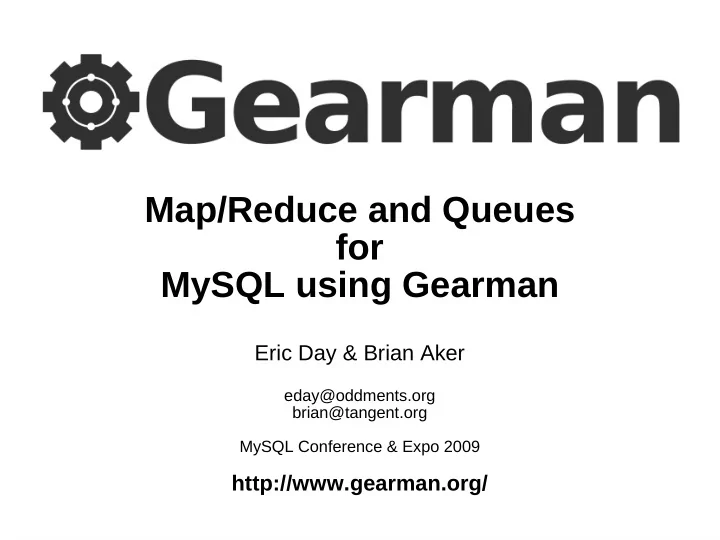

Map/Reduce and Queues for MySQL using Gearman Eric Day & Brian Aker eday@oddments.org brian@tangent.org MySQL Conference & Expo 2009 http://www.gearman.org/
Grazr
Solution
“The way I like to think of Gearman is as a massively distributed, massively fault tolerant fork mechanism.” - Joe Stump, Digg
Overview History Recent development How Gearman works Map/Reduce with Gearman Simple example Use case: URL processing Use case: MogileFS Use case: Log aggregation Future plans
History Danga – Brad Fitzpatrick & company Technology behind LiveJournal Related to memcached, MogileFS, Perlbal Gearman: Anagram for “manager” − Gearman, like managers, assign the tasks but do none of the real work themselves Digg: 45+ servers, 400K jobs/day Yahoo: 60+ servers, 6M jobs/day Core component for MogileFS Other client & worker interfaces came later
Recent Development Brian started rewrite in C − Slashdot problem Eric joined after designing a similar system Fully compatible with existing interfaces Wrote MySQL UDFs based on C library New PHP extension based on C library thanks to James Luedke Gearman command line interface New protocol additions Job server is now threaded!
Gearman Benefits Open Source (BSD) Multi-language − Mix clients and workers from different APIs Flexible Application Design − Not restricted to a single distributed model Fast − Simple protocol, C implementation Embeddable − Small & lightweight for applications of all sizes No single point of failure
Gearman Basics Gearman provides a distributed application framework, does not do any real work itself Uses TCP, port 4730 (was port 7003) Client – Create jobs to be run and then send them to a job server Worker – Register with a job server and grab jobs as they come in Job Server – Coordinate the assignment of jobs from clients to workers, handle restarting of jobs if workers go away
Gearman Application Stack
Simple Gearman Cluster
How is this useful? Natural load distribution, easy to scale out Push custom application code closer to the data, into “the cloud” For MySQL & Drizzle, it provides an extended UDF interface for multiple languages and/or distributed processing It acts as the nervous system for how distributed processes communicate Building your own Map/Reduce cluster
Map/Reduce in Gearman Top level client requests some work to be done Intermediate worker splits the work up and sends a chunk to each leaf worker (the “map”) Each leaf worker performs their chunk of work Intermediate worker collects results and aggregates them in some way (the “reduce”) Client receives completed response from intermediate worker Just one way to design such a system
Map/Reduce in Gearman
Simple Example (PHP) $client = new gearman_client(); Client: $client->add_server('127.0.0.1', 4730); list($ret, $result)= $client->do('reverse', 'Hello World!'); print "$result\n"; $worker = new gearman_worker(); Worker: $worker->add_server('127.0.0.1', 4730); $worker->add_function('reverse', 'my_reverse_fn'); while (1) $worker->work(); function my_reverse_fn($job) { return strrev($job->workload()); }
Running the PHP Example Gearman PHP extension required shell> gearmand -d shell> php worker.php & [1] 17510 shell> php client.php !dlroW olleH shell>
Simple Example (MySQL) Gearman MySQL UDF required mysql> SELECT gman_servers_set("127.0.0.1:4730") AS result; +--------+ | result | +--------+ | NULL | +--------+ 1 row in set (0.00 sec) mysql> SELECT gman_do('reverse', 'Hello World!') AS result; +--------------+ | result | +--------------+ | !dlroW olleH | +--------------+ 1 row in set (0.00 sec)
Use case: MogileFS Distributed Filesystem Replication Gearman provides: − Routing − Tracker notification (Recently ported to Drizzle)
Use case: URL processing We have a collection of URLs Need to cache some information about the − RSS aggregating, search indexing, ... MySQL for storage MySQL triggers Gearman for queue and concurrency Gearman background jobs Scale to more instances easily
Use case: URL processing Insert rows into table to start Gearman jobs Gearman UDF will queue all URLs that need to be fetched in the job server PHP worker will: − Grab job from the job server − Fetch content of URL passed in from job − Connect to MySQL database − Insert the content into the 'content' column − Return nothing (since it's a background job)
Use case: URL processing
Use case: URL processing # Setup table CREATE TABLE url ( id INT UNSIGNED AUTO_INCREMENT PRIMARY KEY, url VARCHAR(255) NOT NULL, content LONGBLOB ); # Create Gearman trigger CREATE TRIGGER url_get BEFORE INSERT ON url FOR EACH ROW SET @ret=gman_do_background('url_get', NEW.url);
Use case: URL processing $worker = new gearman_worker(); $worker->add_server(); $worker->add_function('url_get', 'url_get_fn'); while(1) $worker->work(); function url_get_fn($job) { $url = $job->workload(); $content = fetch_url($url); # Process data in some useful way $content = mysql_escape_string($content); mysql_connect('127.0.0.1', 'root'); mysql_select_db('test'); mysql_query(“UPDATE url SET content='$content' ” . “WHERE url='$url'”); }
Use case: URL processing # Insert URLs mysql> INSERT INTO url SET url='http://www.mysql.com/'; mysql> INSERT INTO url SET url='http://www.gearman.org/'; mysql> INSERT INTO url SET url='http://www.drizzle.org/'; # Wait a moment while workers get the URLs and update table mysql> SELECT id,url,LENGTH(content) AS length FROM url; +----+-------------------------+--------+ | id | url | length | +----+-------------------------+--------+ | 1 | http://www.mysql.com/ | 17665 | | 2 | http://www.gearman.org/ | 16291 | | 3 | http://www.drizzle.org/ | 45595 | +----+-------------------------+--------+ 3 rows in set (0.00 sec)
Use case: Log aggregation A collection of logs spread across multiple machines Need one consistent view Easy way to scan and process these logs Map/Reduce-like power for analysis Flexibility to push your own code into the log storage nodes − Saves on network I/O Merge-sort aggregate algorithms
Use case: Log aggregation Look at gathering Apache logs Gearman client integration − tail -f access_log | gearman -n -f logger − CustomLog "|gearman -n -f logger" common − Write a simple Gearman Apache logging module Multiple Gearman workers − Partition logs − Good for both writing and reading loads Write Gearman clients and workers to analyze the data (distributed grep, summaries, ...)
Use case: Log aggregation
What's next? Persistent queues and replication very soon More language interfaces based on C library (using SWIG wrappers or native clients), Drizzle UDFs, PostgreSQL functions Native Java interface Improved event notification, statistics gathering, and reporting Drizzle replication and query analyzer Dynamic code upgrades in cloud environment − “Point & Click” Map/Reduce
Get in touch! http://www.gearman.org/ #gearman on irc.freenode.net http://groups.google.com/group/gearman Questions?
Recommend
More recommend